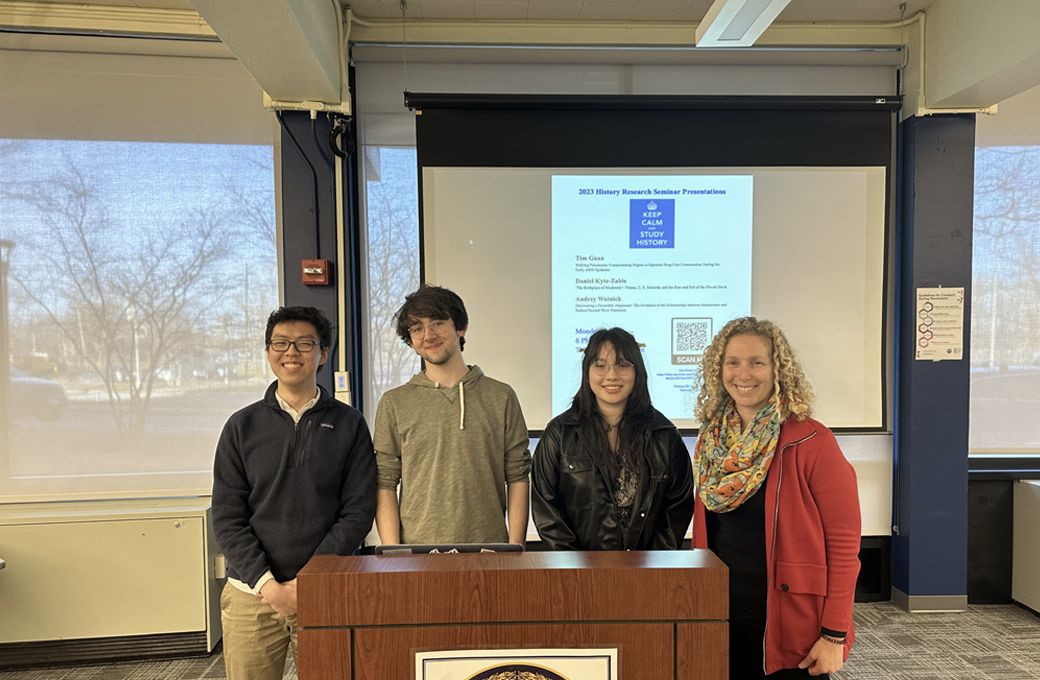How did stigma affect the lives of drug users in the 1980s? How successful was Carl Schorske’s 1979 historical nonfiction “Fin-de-siècle Vienna: Politics and Culture” in capturing Vienna at the turn of the 20th century? How did mainstream and radical second wave feminists work with and against one another during the mid-20th century?
For the last eight months, Tim Guan, Daniel Kyte-Zabel, and Audrey Watnick (all ’23), the three members of History Department Head Dr. Susan Glazer’s Senior Research Seminar, strove to answer these questions respectively, as they wrote 20-page papers. To showcase the products of their extensive research, the three presented before an audience of 20 fellow students, family, and faculty, on April 3 at 6 p.m. in the Community Room.
“Quite the odyssey we’ve had this evening,” Dr. Glazer said at the event’s close, referring to the range of topics covered and the energy devoted to them. Turning to her three students, she said, “I hope you know how proud I am of you. I hope you are proud of the process and what you’ve accomplished.”
The Senior Research Seminar demands that students conduct more research and incorporate more primary and scholarly secondary sources than the Junior History Research Paper does, per the Program Planning Guide. In trimester one, the students conducted research, produced a draft thesis, and created an outline, and in trimester two they wrote their papers.
“It’s a really cool project,” Dr. Glazer said. “It allows students to dream up a project and to see it through.”
Tim, in examining the experiences of “People Who Inject Drugs” (PWID) in the 1980s, determined that the stigma attached to their condition influenced the poor governmental response to the AIDS and opioid epidemics, the lack of press coverage on their condition, and their fraught interactions with everyday people.
“Stigma hindered progress and prevented awareness from being raised,” Tim said.
That stigma was a result not only of a societal revulsion against drug-users, but against other aspects of their identities, such as their sexual orientation, he said.
“There’s a stigma that AIDS only infected homosexuals,” he said. “They’re ostracized from their family and religion. They had to deal with trauma throughout their lives.”
Tim concluded his presentation with mentions of several ways through which PWID combatted stigma, including distributing posters depicting children suffering from AIDS, occupying the New York Stock Exchange in 1989, and calling for a rapid development of a cure.
Daniel investigated the effect of the 1979 Pulitzer-Prize-winning book “Fin-de-siècle Vienna: Politics and Culture,” by Schorske, a Princeton University cultural historian specializing in Germanic affairs, on the United States and Austria. The seven essays which compose the book present the Vienna of 80 years prior, embroiled in crisis after the conservative and anti-Semitic factions united to establish a political monopoly, as analogous to Schorske’s contemporary United States, which was threatened by right-wing populism.
“The narrative was driven by a desire to speak to conditions in post-war America,” Daniel said.
The book’s popularity in the United States indicates that its insights were apt, Daniel said.
“People found within history a mirror for their own present conditions and daily lives,” he said.
In Austria, however, Schorske’s book was far less resonant because it strayed from an objective portrayal of turn-of-the-century Vienna. At a time when Austria was grappling with its complicity in the Holocaust, Schorkse’s deference to subjective history was an anathema, Daniel said.
Though it received a lukewarm reception in Austria, the book’s success in the United States demonstrates the reasons why certain history gains recognition at later periods, Daniel said.
“The reason why we are interested in certain history is because of the present,” he said. “History gains momentum because of things that are happening now. History is in dutiful service of the present.”
Audrey analyzed the interactions between the mainstream and radical second wave feminist movements in the mid-20th century. She discovered that the mainstream movement supported many existing societal structures such as capitalism and white supremacy, while the radical feminist movement demanded an upheaval of society.
A surprising overlap in the agendas of the mainstream and radical groups was their support for reproductive rights. A coalition of the two was instrumental in the passage of Roe v. Wade, Audrey said.
Understanding the contours of second wave feminism is essential, Audrey said.
“It’s important to understand the nuances in second wave feminism because it was a precursor to much of our current movements surrounding gender equality and reproductive rights,” she said. “In order to find a way to have success in the future in these movements, it can be helpful to see what those before did, especially how they were able to unite for certain common interests.”
This project intensified her burgeoning love for historical research, Audrey said.
“I really enjoyed my topic and was excited to research and write. This experience has led me to wanting to pursue research even more.”





